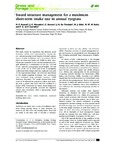Por favor, use este identificador para citar o enlazar este ítem:
http://www.alice.cnptia.embrapa.br/alice/handle/doc/951995| Título: | Sward structure management for a maximum short-term intake rate in annual ryegrass. |
| Autor: | AMARAL, M. F.  MEZZALIRA, J. C.   BREMM, C.   TRINDADE, J. K.   GIBB, M. J.   SUÑÉ, R. W.   CARVALHO, P. C. de F.   |
| Afiliación: | M. F. Amaral; J. C. Mezzalira; C. Bremm; J. K. Da Trindade; M. J. Gibb; RENATA WOLF SUNE MARTINS DA SILVA, CPPSUL; P. C. de F. Carvalho. |
| Año: | 2013 |
| Referencia: | Grass and Forage Science, Oxford, v. 68, n. 2, p. 271-277, June 2013. |
| Descripción: | This study tested the hypothesis that different sward structures, which were constructed by varying the pre- and post-grazing sward heights of annual ryegrass pasture (Lolium multiflorum Lam.) in southern Brazil, affect the short-term intake rate (STIR) by dairy cows. Treatments consisted of four sward-management strategies defined by a combination of two pre- (25 and 15 cm) and two post-grazing sward heights (10 and 5 cm): 15-05, 15-10, 25-05 and 25-10. A completely randomized block design with four replicates was used for the experimental design. The STIR was determined by the double-weighing technique. Jaw movements were evaluated using automatic recorders (IGER Behaviour Recorder). The results showed that treatment 25-10 allowed the animals to collect more herbage with a greater bite mass and thus resulted in a greater STIR. Treatments in which sward height was reduced to 10 cm generally favoured the ingestion process than treatments with a post-grazing sward height of 5 cm. |
| Thesagro: | Azevém Vaca leiteira |
| Tipo de Material: | Artigo de periódico |
| Acceso: | openAccess |
| Aparece en las colecciones: | Artigo em periódico indexado (CPPSUL)  |
Ficheros en este ítem:
| Fichero | Descripción | Tamaño | Formato | |
|---|---|---|---|---|
| SuneGFS.pdf | 469.07 kB | Adobe PDF |  Visualizar/Abrir |









